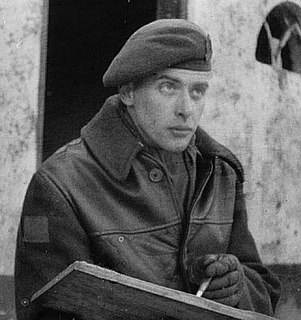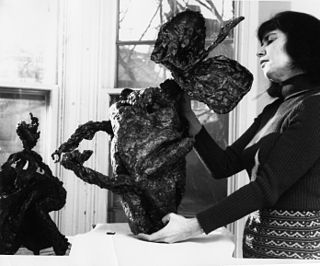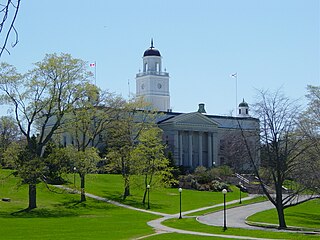
Mary Frances Pratt, CC, RCA was a Canadian painter specializing in photo-realistic still life paintings. While Pratt never thought of her work as being focused on one subject matter, her early works focus on domestic scenes, while some of her later work have a darker undertone, with people as the central subject matter. She painted what appealed to her, being emotionally connected to her subject. Pratt often spoke of conveying the sensuality of light in her paintings, and of the "erotic charge" her chosen subjects possessed.

David Alexander Colville, was a Canadian painter and printmaker who continues to achieve both popular and critical success.
Frank Parker Day was a Canadian athlete, academic and author.

Maud Kathleen Lewis was a Canadian folk artist from Nova Scotia. Lewis lived most of her life in poverty in a small house in Marshalltown, Nova Scotia, achieving national recognition in 1964 and 1965. She is best known for her cheerful paintings of landscapes, animals, and flowers, which offer a nostalgic and optimistic vision of her native province. Several books, plays and films have since been produced about her. Lewis remains one of Canada's most celebrated folk artists; her works and the restored Maud Lewis House are displayed in the Art Gallery of Nova Scotia.

The Art Gallery of Nova Scotia (AGNS) is a public provincial art museum based in Halifax, Nova Scotia, Canada. The art museum's primary building complex is located in downtown Halifax and takes up approximately 6,200 square metres (67,000 sq ft) of space. The museum complex comprises the former Dominion building and two floors of the adjacent Provincial building.
Carol Hoorn Fraser (1930–1991) was an American-born figurative artist who worked for thirty years in Nova Scotia, Canada.

Forshaw Day (1831–1903) was a Canadian artist known for his landscapes.

Richard Hayley Lever was an Australian-American painter, etcher, lecturer and art teacher. His work was part of the art competitions at the 1928 Summer Olympics and the 1932 Summer Olympics.

Sarah Jeanette Jackson, néeSherman was a Canadian artist. Jackson first became known for her sculptures and drawings, and then for her photocopy and digital art. She was an early user of the photocopier to make art, and used this practice to embrace mail art.
The Killam Memorial Library is the main library of Dalhousie University, and the largest academic library in the Maritimes, comprising 230,000 square feet (21,000 m2) of space.

Leslie Raymond Fairn was a Canadian architect whose career is notable for its longevity and for the range of styles it encompassed, including Beaux Arts and Modernism. Most of his work was completed in the Maritimes.
Ursula Johnson is a multidisciplinary Mi’kmaq artist based in Halifax, Nova Scotia, Canada. Her work combines the Mi’kmaq tradition of basket weaving with sculpture, installation, and performance art. In all its manifestations her work operates as didactic intervention, seeking to both confront and educate her viewers about issues of identity, colonial history, tradition, and cultural practice. In 2017 she won the Sobey Art Award.
Monica Tap is a Canadian painter, artist and educator. She lives in Toronto, Ontario, and teaches at the University of Guelph. She is known for engaging and challenging conventions concerning landscape and still-life painting.
Susan G. Scott RCA (1949) is a Canadian artist known for contemporary figurative painting. Her work is found in national and international public collections including the Canada Council for the Arts, Musée national des beaux-arts du Québec, Musée d'art contemporain de Montréal, Art Gallery of Nova Scotia, Collection du Fonds régional d'art contemporain d’Île-de-France in Paris, Canada - Israel Cultural Foundation in Jerusalem and Houston Baptist University in Texas. She was elected to the Royal Canadian Academy of Arts (RCA) in 2013.
Nancy Edell was an American-born Canadian artist, best known for her rug hooking practice that pushed the boundaries between art and craft. Her practice also included animated film, woodcut, monotypes and drawing which often expressed surrealist themes. Edell believed an artist’s work should be an expression of their own personal experience. Her work was rooted in feminism and drew inspiration from her dreams, religion and politics. Her work is recognized for its dream like qualities, art historical references, sensuality, unabashed sexuality, narrative and subversive wit.
Mary Marguerite Porter Zwicker was a Canadian artist and art promoter from Halifax, Nova Scotia. Known for her watercolor paintings of landscapes and villages in Nova Scotia, Zwicker exhibited her work at the Royal Canadian Academy of Arts, the Montreal Art Association, and the Art Gallery of Nova Scotia. Together with her husband, Leroy Zwicker, she owned and operated Zwicker's Gallery; for most of the 20th century, Zwicker's Gallery was the only Halifax gallery that routinely held art exhibits open to the public. It still operates.

Maria Morris Miller (1813–1875) was a Canadian artist from Halifax, Nova Scotia who is known for her botanical paintings and illustrations. She presented her work to Queen Victoria and received royal patronage for life. She is also the first professional woman artist in Nova Scotia, recognized in her field during her active career years. She worked with scientists and government officials, garnering her accolades as the "Audubon of Nova Scotian field flowers".
Buseje Bailey is a Canadian artist and curator working in video and multi-media whose work explores the construction of the diasporic Black self. Bailey's multidisciplinary work explores themes of the Black diasporic identity and women's history. Her video work is distributed by V tape in Toronto. She was cited as an outstanding Black Canadian artist in a 2018 article published by the Canadian Broadcasting Corporation.
Miya Turnbull is an artist based in Halifax, Nova Scotia, Canada. She is of Japanese and Canadian ancestry and uses this to explore her identity in her work. Her work consists of photography, video, projection, and masks. Miya has had several installations around Canada and internationally. Miya's mask work has been inspired by quotes from Joseph Campbell and Andre Berthiaume.
Henry M. Rosenberg was a painter whose style varied from realism to tonalism, symbolism and impressionism, as well as a printmaker and educator. He was Principal of the Victoria School of Art and Design from 1898 to 1910. Writers on the history of art in Nova Scotia call him the "grand old man of Nova Scotian art".









